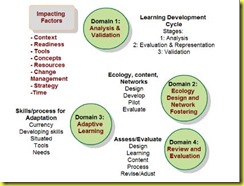I understand that many people don’t agree with the way I do things, online and offline. I learn by doing. I saw a learning opportunity that could be shared and beneficial... I followed my heart. In this post I will describe the background story behind the creation of BaeL project and the instructional design issues that, with my interactions on the CCK08 course, I see now.
My contact with Andy Pincon from Digital Workforce Education Society or Digibridge was triggered by a final comment I posted at BaW07. He contacted me by email, I told him that it was an incredible coincidence that he saw me because I had been learning with Mercedes (the voice in the video) about his long distance Chicago project with immigrants . As part of Mercedes’ workshop I trained for free a digitally illiterate adult to learn basic computer skills like turning on the PC, use of mouse, use of keyboard, etc., using Alado as virtual classroom. The student was in another place of town with a moderator by his side listening to me and following tutorials. By the way, the Mexican organization linked to Digibridge is Innovative Soft.
The following year, at BaW08, I mentioned in the mailing list that I wanted to practice what I had learned, I did not want to spend another year away from online teaching and that I would get a group of students to do so. Sharon Betts suggested me to connect my students to hers at TLG, Andy Pincon suggested me to contact Unete and to consider LearnFree programs. Bernice La Lucerne, Jose Antonio Da Silva, Ronaldo Lima, Nergiz Kern and Dennis Oliver’s generous ideas and questions about the issues I was considering, helped me to decide how to go about it.
For me the process described above shows that, as George Siemens mentions again in this Instructional Design week, all learning starts with a connection and that attributes of connections influence knowledge. By talking, visiting sites, exploring web 2.0 platforms, asking questions, interacting with them and their experiences I decided to leave BaeL at 21st Classes inactive, to create BaeL at Ning as virtual support community and designed a short four weeks online workshop using AprendeLibre computer tutorials as content material, Yahoo Messenger as live sessions site and BaeL-PC Yahoo Group as forum and mailing list. The workshop was launched the 24th of March 2008.
According to Renata Phelps’ paper, I designed a complex non linear learning environment. If I had read George’s Learning Development Cycle or watched his presentation on Instructional Design and Connectivism maybe I would have done things differently. I say “maybe” because the Context, Readiness, Tools, Equipment Available and Resources were the Impacting Factors to plan the design of the workshop.
It was a free activity, not related to school in any way. My students and I were working from Cyber Places which created difficulties due to the “strange” sites I required access to. The target group age range was 14 to 18 years old, some of them worked and studied, some went to school in the morning while others went in the afternoon, non of them spoke English, the older ones used the computer to chat, the e-mail to send PPP presentations and had Metroflogs to post images. Some of us did not know how to use a computer properly. The sites are still active, the last member is a young single mum who wants to learn to use computer programs to get a job as a secretary or receptionist. I am glad to help and continue learning with her participation.

6 comments:
I also respond to the idea that all learning starts with connection. And George's slide that you show in your post is one of the more useful things I have encountered in this course.
But I was most struck by your personal note at the end, about your 'core network' and the emotional impact of the course. This, too, is learning, and I think we should be open to sharing and discussing our emotional insights and reactions as well as our more cerebral ones. Those are also important elements of connection and something we need to consider as educators as we design connectivity into our teaching and learning. Does your core have hard boundaries, do you think, or is it more a question of degrees of connectedness, of a more fuzzy notion?
Thank you Ed and Maru for starting a thread on the emotional aspects of connectivism. How would you do that with students, in a way that keeps both you and students safe?
Hi Maru,
I clicked on the link to your blog post in CCK08 Daily as the title appealed to me. The emotional aspects are important but can be difficult to discuss 'in public'. I noticed that Stephen D had praised someone sharing their grade as 'living the spirit of connectivism'. What is the place of private discussion in networks? Important to me.
Hi Edd, Sara and Francis!
Thanks for your comments. I find the emotions issue important as well. I posted my answers in a new post
In fact, the post is to answer you. I find your contributions of great value and they have helped me to sort myself out.
See you around. Maru :X
PS. I deleted my own previous comment because the link did not work, I hope it works now.
Well, bad fingers to post links today http://snurl.com/4r0hn
I'm sorry to ask you but if it doesn't work please copy to browser or go to 27th October post.
New attempt to get an active link
I apologize for this.
Maru :X
Post a Comment